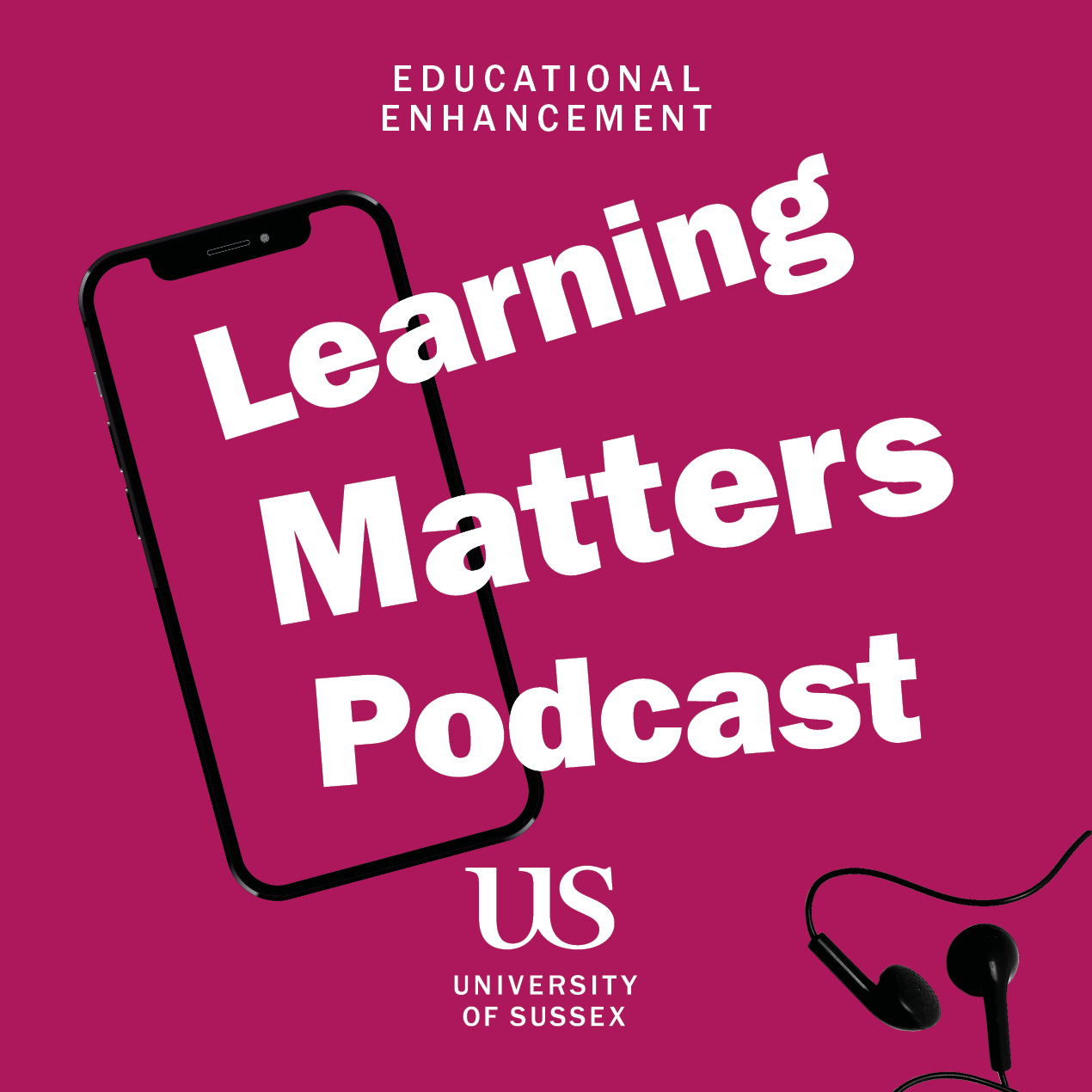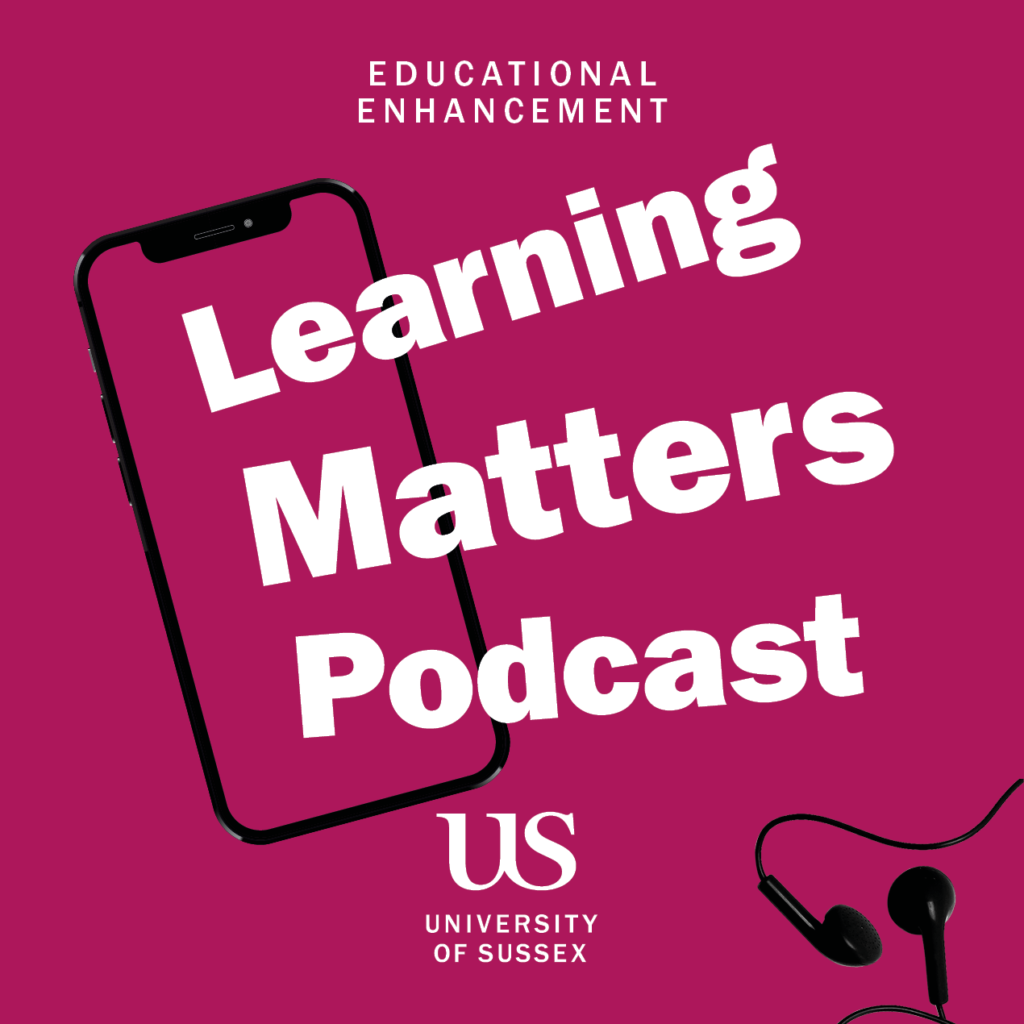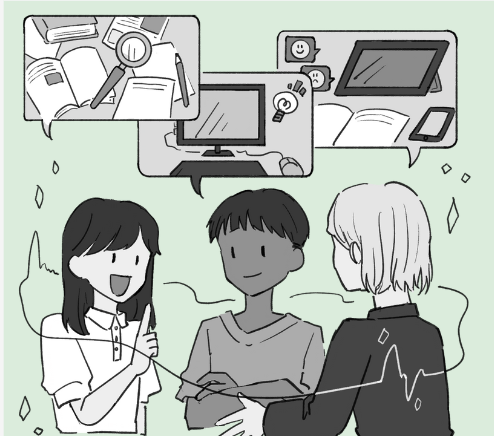

The Learning Matters Podcast captures insights into, experiences of, and conversations around education at the University of Sussex. The podcast is hosted by Prof Wendy Garnham and Dr Heather Taylor. It runs monthly, and each month is centred around a particular theme. The theme of our fifth episode is ‘creating an autism-friendly university’, and we will hear from Dr Sophie Anns (Associate Professor in Psychology).
Recording
Listen to the recording of episode 5 on Spotify.
Transcript
Heather Taylor
Welcome to the Learning Matters Podcast from the University of Sussex, where we capture insights, experiences and conversations around education at our institution and beyond. Our theme for this episode is neurodiversity and our guest is Doctor Sophie Anns from Psychology. Our names are Heather Taylor and Wendy Garnham and we are your presenters today. Welcome everyone.
All
Hello.
Wendy Garnham
So, Sophie, can you tell us a little about the context of your scholarship in the area of neurodiversity?
Sophie Anns
Sure. OK. Before I came to Sussex, I did my PhD in Learning and Memory in children with complex needs with autism. And that gave me a really sort of good insight into sort of how children learn and some of that research was also applied in another study that I did with the criminal justice system, which was looking at how to interview autistic witnesses. And I thought that some of that we could really apply to how students learn at University, so when I was at Sussex, I thought, oh, you know, let’s look at that, not so much memory, but more about learning and how children learn and obviously there has been a very positive move in the theories behind autism and neurodiversity, lot more of neurofirmative approaches that are around now, which is really nice to be able to tap into, and also look at students at university and how they learn.
Heather Taylor 1:40
What issues do you see as being particularly pressing in this area?
Sophie Anns
There’s quite a few. I would say the main one is probably the rise in numbers of neurodivergent students that we’re seeing, especially in the last few years. And I’m sure you guys also notice it in your classes. It’s across the board and some of this is related to increased number of diagnosis as well. So yeah, there’s overall sort of massive increase. And I think we’re at the point where universities, as an institution, we’re just not set up for it at many levels. Practically speaking, at a sort of spatial and infrastructural level, but also the way we teach, the way we disseminate and share knowledge, the way we assess it. Basically, across the board a switch is just really, really important and if we focus more on autism, which is more my sort of expertise or sort of specialism. And if we look at sort of autistic people generally they have such a need and desire to have fulfilled and focused interests and that on paper, basically an autistic student, on paper, should thrive at university. Because of this, their abilities and strengths, their focused interest, which is what a degree actually is of course. And also, their detailed focused thinking. So, we should be able to maximize and capitalize on those strengths. Specifically, again, you know in sort of all degrees across the board, there’s going to be that element that might not have been present so much at school. So really on paper, they should thrive at university. And the sad thing is that they’re not. There’s a big gap here that we need to address.
Wendy Garnham 3:38
Yeah. I think sometimes it’s having the opportunity to demonstrate those particular skills as missing isn’t it?
Sophie Anns
Yeah. It’s enabling that and recognising it as a strength. And you know in the way we teach in the way we assess as well. I think it’s, you know, more present in some degrees, perhaps in others, just by the very nature of the discipline. But it’s something that we, yeah, could really draw out of students more I think.
Wendy Garnham
I think sometimes it’s about taking the risk in terms of changes to what we’re doing and teaching. Quite off putting I think. But doesn’t mean we shouldn’t do it, but I do think that is a barrier. So, can you, on that note, give us an idea of what scholarship projects you are or have been working on?
Sophie Anns
Yeah. So, I’ve been working on a few. Probably the first one that I worked on was
as I said earlier, looking at this sort of learning in autistic students, and I wanted to look of course at well-being because that impacts hugely their studies. It’s just too huge in autism. So, I wanted to focus purely on academic learning experiences. And by that I mean sort of everything that comes into their academic learning basically. So yeah, it’s going to be what’s going on outside of their work as well. So of course, mental health is going to impact that, but it’s more looking at things like all the different learning contexts, so examinations, whether they’re in- person or online, different types of coursework and assessment. How well they do at self-directed study?
So, we basically developed a measure, a questionnaire exploring these academic learning experiences and we looked at these sort of different learning contexts and then we also looked at some other elements that we called dimensions. So, these were more around things like sensory reactivity, which is big in autism. In autism, sensory issues can be sort of hypo or hypersensitive, and that could in the learning context translate to things like what it’s like in a lecture theatre – can they actually focus and concentrate if there’s a bright light, or if someone’s eating a packet of crisps next to you, for example? This questionnaire that we created really was trying to capture these in a real sort of context. These rich contexts of experiences, other things we looked at with things like social anxiety in group learning, and things around peer support, things around mono focus, which was our sort of term for combining monotropism and hyperfocus. So, the ability to have either this tunnel vision or focusing on one thing at a time or that sort of detailed oriented processing as well. And one other thing I can’t remember off the top of my head. So anyway, we developed this measure, had huge feedback from students on that, and we’re just trying to, at the moment, validate it. We’re on our second round of revisions with the journal, so we’re hoping that’s going to be a measure that will be validated and published and that will be able to be used, obviously not just in research, but also with Student Services – they can use it on a one to one basis with students to help them answer questions about how they’re doing and look at where their strengths and weaknesses, in terms of their experiences, actually are.
Wendy Garnham 7:10
Sounds like a fantastic resource.
Sophie Anns
I hope so.
Wendy Garnham
One that will be well used, I think.
Heather Taylor
Yeah. In terms of, you know, you said you got student feedback. So how did you approach that? How did you identify students to give you the feedback? Was the uptake good, how did they feel about the experience of giving you too many questions in a row?
Sophie Anns
No, I mean, I’m really glad you asked that because it’s really important. This took actually years to develop and I started with some of my project students, my undergrad project students, getting them to think about the academic learning experience. This was a co-created participatory research design. And they were mainly non autistic at that point, but we got them to sort of sketch out what academic learning experiences for you? What do they look like? And then we involve some autistic students and we ran then a pilot study. This was just after the pandemic or sort of coming out of the pandemic. We put it online and we got hundreds and hundreds of students to take part. I think in the second round we also put it on SONA for psychology students here, but we’ve had about 1000 responses. And worldwide from other countries as well.
Wendy Garnham 8:29
It’s incredible, that many participants.
Sophie Anns
Yeah, we were lucky. I think if we did it now, we wouldn’t get so many because I think post pandemic everyone’s a bit sort of fatigued by, you know, there’s a bit of participant fatigue out there. But for then it was really, really good. But we kept that co-creation process going, so we did a pilot study first and then we did it again, we revised all the items in the questionnaire again with several autistic students, and one particularly that worked on it in her placement year. And she’s now a first author on the paper, which is great. It’s actually, you know, really beneficial for people involved as well.
Heather Taylor
I actually really like the fact, though, that it started from students. You’ve gone and got the student experience to begin with. And then, because it actually is, well, doing it that way, I know you said the majority of them are undergraduate students who didn’t have autism to begin with. But I think finding out what potentially neurotypical students are experiencing in the classroom and then thinking about, OK, it almost gives you that way to look at, is it an equal experience, you know to start from there? So I think that’s great, and it’s just so nice that the whole way it’s been very much student-informed, sort of student co-lead, its lovely.
Wendy Garnham 9:51
I think that enables you as well to get at the details, isn’t it? Because there’s a lot of very general advice, but actually something that really gets to the nitty gritty of what that experience is like in terms of the detailed experience of what’s going on in a lecture theatre. You know that I think is really useful. My next question is what impact do you hope your scholarship will have? I have one particular interest myself, in that, which is given what you found out, are there plans to develop sort of recommendations or ideas for how to support neurodiversity in the classroom as a result of your scholarship?
Sophie Anns
Yeah, quite a few. So we’ve got, hopefully, this measure is going to get validated in a research context, which would be really good. We have some universities in the States already using it in their disability services. We created an infographic which is full of recommendations and there’s a research base which is on the University Academic Development website I think already, we’re going to update that with news of figures from the actual study, but basically it’s all the same, it’s just different numbers, but you know the same thing occurred, the same findings exist. Also I was very lucky to visit a university in India this year where we’re trying to set up a partnership between our schools and I shared the infographic and the study with them and they’re going to be able to use it with their students. And then we later had this really nice sort of research conclave discussion where a few of us from psychology went over in September, and one of the sessions was about the lived experience of neurodivergent students. And there we were sort of able to sort of compare the cross cultural differences between student experiences. So that was really, really useful. And I hope useful for them and their students over there as well. We all benefited from it and it was really interesting. And then also what this study has sort of led into has being this new collaboration with Anna Franklin and John Moore who look at visual discomfort. And Claire, who’s the first author and worked on this, the other previous study, is now doing her PhD in this, and this project is going to be looking at visual discomfort in autism, but it’s going to have a focus on educational environments and she’s going to use the Sussex campus as her sort of first trial, if you like. She’s going to again involve students, it’s a participatory project, and get them to sort of go around campus and see where they experience visual discomfort and sort of take photographs of that, and create the stimuli from that and then we’re going to get those rated by students and other people later. There’s lots of aspects to this project. But I think the important thing that’s going to come out of this project is it is going to be able to inform designers and architects and get them to revise any guidelines there are around neurodiversity in spaces. So that project particularly is around, yeah, space, you know, visual discomfort and space. And some other work that I’ve been doing as well, sort of trying to get this initiative going at Sussex, looking at trying to make Sussex a more autism friend university, with that more neurodiversity friendly as a whole. So we’ve worked a little bit with the library looking at the spaces there, working with academic development on sort of staff training. Probably some other things that I can’t think of off the top of my head. I guess it sort of spanned out into quite a few different projects in a sense.
Wendy Garnham 13:38
Yeah, it sounds like the impact’s been quite diverse.
Heather Taylor
I think that the thing you said about the lights, so that is so common. I don’t know whether the student’s autistic or, I can’t remember who’s said when. But it’s very common when I go into a teaching space that they won’t like the lights, you know, want the lights off, which is fair enough. But yeah, there is quite a need for this, and it’s actually really important because I think if I just ignored them and kept the lights as they are, they would really struggle to concentrate. And like I said, I don’t think this is always necessarily autistic students, I think it’s quite common that you know, for whatever reasons it might be, these sorts of fluorescent lights can really interrupt with someone’s concentration. But I suppose that’s the way with when you’re trying to make a more neurodiverse friendly environment it does tend to benefit everyone, doesn’t it?
Sophie Anns
Yes, absolutely. And I think that’s a problem, especially with autism specifically and neurodivergence more generally is that people want a sort of one-size-fits-all tick box, this is how we solve it all. And on one side we’re never going to have that. It’s always about just trying to tailor everything to the individual but at the same time you say very rightly Heather, if we sort of tap into principles of universal design, some of the things most of the things that are going to benefit neurodivergent people is going to benefit all. So it’s striking that balance. So yeah, I think that’s really important and lighting is absolutely key. Yeah, it really. I have the same when I go into you know seminars or workshops, the first thing I do is like, right, let’s all sort out the lighting, the seating and the lighting. And you know, it’s a free for all.
Wendy Garnham
Yeah. I wonder just on that note, how neurodiverse students find outdoor learning. Just as a contrast to that indoor lighting, artificial lighting and sort of very constrained environment, whether learning outdoors is beneficial or whether there’s a sort of a similar sort of issue with over stimulation but in a different way, a different context. But that would be interesting to explore.
Sophie Anns 15:54
It’s really interesting and I think generally people would say it’s probably better because it’s natural, it’s the outdoors, there’s sort of less stimulation. But I know some students that really struggle with the wind, for example, and as we know here, it’s really windy. So yeah, there could be other sort of sensory sensitivities around. Rain. Wind. What’s happening? And it’s quite interesting because that taps into the sort of biophilia sort of theory about how we often assume that nature is best and less stressful. And this comes into some of the work that Claire’s going to be looking at around visual discomfort from a sort of more theoretical standpoint. But we assume natural is better and sometimes it. But actually, if we think about nature, it’s actually a very stimulating environment to be in. And I think there’s some research and I say this very broadly and vaguely, that says, and I’m quoting someone else here, that if you’re already stressed then being in nature is not going to calm you down and help. But if you’re not, then it will. And I’m sure it’s not as straightforward as that. I think that’s quite interesting. But I would love to, you know, personally do much more sort of outdoor teaching like you do, Wendy. But just look at the weather half the time!
Wendy Garnham
Yeah, I’ve done a walking seminar in the cold today and it was freezing. But it does just bring a different atmosphere I think to what we’re doing. So I was saying to Heather earlier, we were sitting in the seminar room – nobody wanted to talk to anybody else. Was very quiet. Very short answers to questions where you know I got an answer at all. The minute we stepped outside, they all started talking to each other, to me, I think there’s something about that idea that if you’re walking and talking the conversation flows naturally, it doesn’t feel like there’s a spotlight on you. It just creates this nice sort of atmosphere of, you know, it’s easy to talk and it’s easy to share ideas and thoughts. But interestingly, we were looking at different blue spaces on campus today and looking at how restorative they found the different blue spaces and what factors might be sort of implicated in their decisions. And so yeah, really interesting, it’ll be interesting to see what their results are
Sophie Anns
Can I ask you a question? What’s your maximum number for a walking seminar?
Wendy Garnham
Normally our seminars are about 20 students max. Today it was my smaller group, so I had seven students, but I mean, you can do it in different ways. Today we did just pairing up or a small group of three, and I gave them like a list of where we were going. They had that in advance so that they knew what the plan was, what the route was. I gave them their questions to consider at each location, so yeah, basically it worked really well because we were all moving together as one. But they were chatting within their pairs or their small groups of three, and it really did facilitate conversation. Yeah, it works. And I think you can as long as you sort of have those smaller groups within a bigger group, it works. It’s just I think trying to do with everybody talking to everyone else or just one person talking amongst the whole crowd I’m not sure that would be as effective. It’s that idea that when you’re walking, whoever you’re next to, it’s just easy to generate conversation. And even at this stage in term, there were students there that hadn’t met, or at least hadn’t worked together before that were introducing themselves to each other. And without any intervention from me, it was just naturally happening. So yeah, I think it’s something that’s quite interesting in terms of neurodiversity and how it can break down barriers. But it’d be interesting to see for, you know, autism, how the symptoms there and the experiences actually feed into that.
Sophie Anns 20:09
Definitely. I mean, I think it generally it would be really, really helpful and especially alleviating that social anxiety and sort of it takes a focus off you, doesn’t it as well. Just sort of more about chatting with the other person. And you’re out in the fresh air, which is always good, even if it’s freezing. They can also, you know, complain about how cold it is as well. Part of a bonding experience as well.
Wendy Garnham
Exactly. But I think it also takes the onus off of us as the instructor because it does sort of strip away that hierarchy. It does sort of facilitate that sort of cooperative collaborative talk. So yeah, it’s it’ll be an interesting one to explore, I think.
Heather Taylor
What advice would you give to anyone regarding scholarship in the area of neurodiversity?
Sophie Anns
I think probably one of the first things I was saying, and it’s leads back to your point, Heather, that you mentioned earlier is about including the neurodivergent students in your research, if possible or projects or work whatever it is that you’re doing. Because that’s just key in getting that, you know, co-creating whatever you’re doing with them. And if it’s research trying to do participatory research with them and, you know, putting them at the sort of centre of the activity or the task or the research, I think it’s really important. So that would be one bit of advice and I think another thing, maybe something that I found useful has been collaborating with other people, not just at Sussex, but elsewhere. If I think about that PhD, how that’s come about, that’s the sort of collaboration, which has just been wonderful. And also I think sometimes, you know, some pedagogical research I come across, sometimes can suffer a little bit, methods wise I would say, and I can say that with you two, because you’re both psychologists, know what I mean? So I think sometimes collaborating with other researchers where there might be, you know, another skill or area that’s missing can be really good. And I think probably the main thing is finding a community or other people to work with, even if again, it that’s not at your own university. And I think if anyone’s interested in doing scholarship work in neurodiversity I can recommend that they join an international community of practice – it’s called Canvas, not to be confused with our learning platform at Sussex, but it stands for let me think, the community of autism. Yeah, Community Autism Network, Virtual Association of Scholars. And I think if you Google that, you’d probably get it. It’s an international network that are all looking at, basically autistic students at university and I think that would be a really good starting point and a great thing to join. And I think it’s just finding your people and working with others and also in an interdisciplinary way, especially with scholarship and pedagogical work. I think we have so much freedom to do that and that’s one of the main areas where I actually do love this role is that, you know, I just get to work with so many different people in different sort of subject areas. Also with professional services with EE here as well as Academic Development, it’s sort of across the board really, Student Services.
Wendy Garnham 23:36
I would like to thank our guests Sophie Anns.
Sophie Anns
Well, thank you very much for having me also.
Wendy Garnham
And thank you for listening. Goodbye.
Wendy Garnham
This has been the Learning Matters Podcast from the University of Sussex, created by Sarah Watson, Wendy Garnham and Heather Taylor, and produced by Simon Overton. For more episodes as well as articles, blogs, case studies and infographics please visit blogs.sussex.ac.uk/learningmatters.
Simon Overton 24:25
This is Simon, the producer. I’m just going to jump in, I hope you don’t mind Heather and Wendy if I do. So I was very interested to understand a little bit more. You’ve mentioned visual discomfort a few times, and I’m getting a sort of a picture in my mind of what that is. We have talked, Wendy and Heather have, a little bit about sort of what I guess is audio discomfort, buzzy things and things like that. But, could you expand a little bit on what visual discomfort is and how that might impact on students at university?
Sophie Anns
Sure. That’s a really good question. And I don’t know if I can that well because I don’t really get it, lots of us don’t. I think most of us can relate to audio discomfort a lot more easily, but say with visual discomfort, it could be like now I’m looking at these bricks in front of me. So I’m looking at sort of a brick, literally a brick wall. So for some people, all those lines could be quite sort of uniform and comforting. For others, maybe the contrast between the dark colour brick and the cement in the middle would be too much, so it could be one or the other of course, but that sort of maybe the sort of things we’re going to be thinking about. I mean, I’m only going on what other people have said, so things that it’s often to do with lines. Might be staircases, corridors and obviously lighting, lighting always comes into it. And then I guess images of nature, so the trees you know, generally most likely going to be positive. But I think it’s more the architecture and the harsh lines and the contrast of the colours. With these incidents of visual discomfort, it’s not just that ‘Oh, I’m not really sure I like the look of that’, for some autistic people that can cause actual physical pain, and they might feel it as a sort of burning sensation through their spinal cord, for example. Or it means they just can’t focus in any way. You know it’s quite extreme because I think even, you know, for myself as neurotypical person, I can relate to the idea of it. I don’t really experience it, but I can imagine. But actually, you know, for autistic people and probably some other people that are neurodivergent it can translate as physical pain through the body. So it’s really important to investigate it for sure.
Simon Overton 26:35
A funny and very simple fix for one of these. So with the flickering, our electrical system in the UK is 50 hertz . So the light is switching on and switching off 50 times every second, which is faster than we should be able to see it. But a lot of equipment, camera equipment and projectors and so on, their default is America, which operates at 60 hertz. So when you have that difference, and if your camera is not set up, you will get flashing or a flickering on your phone. If you’ve ever tried to, I don’t know if anybody else tries to do this, but if you ever try to film like a train or a bus and they have the sign on the front, if your phone is not set up right, if it’s set to an American or NTSC instead of PAL, the sign on the front of the bus will flicker because it’s operating at a different refresh rate to your camera. So that’s a really easy thing to fix, you go into the settings and you just set it to the PAL setting – whether it’s the camera or projector or whatever it is, but a lot of people wouldn’t know to do that, and if someone, if a lecturer for example, has recorded a video or something or an online seminar or something like that – the entire thing – and it’s and it’s set to NTSC the entire video is going to be flickering and it’s going to be driving people like me nuts. And again I’m probably neurotypical, I’ve not really being checked one way or the other, but if it irritates me, I can imagine that it’ll be extremely frustrating for someone who is not neurotypical.
Sophie Anns
Yeah, absolutely. I just wonder if you can fix this problem in my kitchen, Simon.
This has been the Learning Matters Podcast from the University of Sussex, created by Sarah Watson, Wendy Garnham, and Heather Taylor, and produced by Simon Overton. For more episodes as well as articles, blogs, case studies, and infographics, please visit The Learning Matters Forum.










